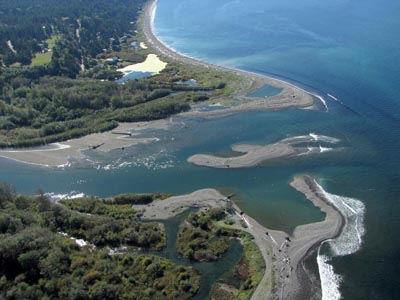Partner Profile: clallam county marine resources committee: focus on the elwha—summer 2012
Back in 2010, when the removal of the Elwha Dams upstream of Port Angeles in the Strait of Juan de Fuca was slated for September 2011, scientists and citizens wondered: would beaches change as the tons of accumulated sediment behind the dams moved downstream and into the nearshore? What would birds do? Would debris patterns change?

An aerial view of Elwha West Beach, where the Elwha River empties into the Strait of Juan de Fuca (J. Gussman)
These were all questions the Clallam County Marine Resources Committee (C-MRC) posed. Citizens, resource managers, tribal members, scientists, educators, and commercial and recreational fishermen join together to form MRCs, promoting marine resource stewardship in 10 of Washington’s coastal counties. Funded by the U.S. Congress in northern Puget Sound through the Northwest
Straits Foundation and the Washington State Legislature on the outer coast, the MRCs solicit for proposals which fill specific community needs, including restoration, monitoring, education and outreach. Cathy Lear, C-MRC committee member, emphasizes that the COASST-MRC partnership is an important one, “MRCs care about the same things COASST cares about: people, shorelines,
wildlife and good management.”
The removal of the dams, approved by an Act of Congress in 1992, is the largest project of its kind in U.S. history. The hope is to restore 70 miles of historic habitat for native salmon—pink, chum, coho, sockeye and the endangered Puget Sound Chinook. Not surprisingly, it’s captured the attention of hundreds of citizens, scientists, resource managers, reporters, writers and film crews. Realizing a need to unite the Elwha’s many stakeholders, Anne Shaffer of the Coastal Watershed Institute put together the Elwha Nearshore Consortium in 2004, which hosts an annual workshop each winter. The Consortium is a big opportunity to bring everyone to the table, “to see, understand and promote the nearshore restoration associated with dam removals,” adds Anne.
With funds from C-MRC, COASST set out to bolster survey coverage in the immediate vicinity of the Elwha River outflow by establishing two new sites in the Strait of Juan de Fuca. Thanks to the help of Dan and Lynda Phillips, who survey Crescent Bay, and Dan Lieberman and Tara Morrow from the Olympic Peninsula Skills Center and their students Bahja Huffman, Alexis Olea and Garret Goudie, who collectively survey Elwha West, both sites have yet to miss a single survey since their inception in October 2010.
The new beaches, when combined with data from Tongue Point and Freshwater Bay (both within 15 km of the river mouth), have displayed the basic “Strait” pattern—a weak peak in late summer–early fall (August–September), with ghost peaks in winter (December) and again in spring (April). Essentially the outer coast Lower 48 pattern, only faint. With the dams just coming out now, we’ve only managed to establish the baseline. Stay tuned for shifts as the wild river re-establishes itself.